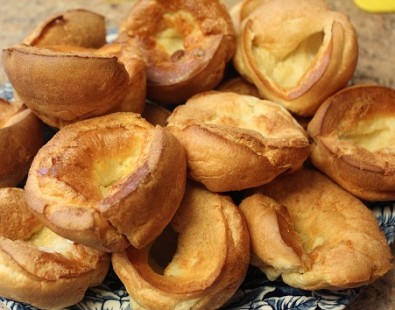31st May, 2019
Britain is known for its amazing variety - all within our small island. This is no less true of its food than of its landscapes and dialects. Many of these foods are associated with specific regions of Britain, some have a unique history and others are eccentrically British. Here is a selection from some of the regions where we offer walking, touring and cycling holidays. Your Adventure Handbook and route directions will highlight where you can find and eat these delicious specialities.
Scotland's haggis
The main ingredients of haggis are probably enough for you to never want to sample it! Having said that, it is delicious - sheep's heart, liver and lungs, and stomach (or sausage casing); onion, oatmeal, suet and spices. It comes presented as a large oval shaped sausage and is often served on Burns night around January 25th which is the birthday of poet Robert Burns, whom the event celebrates. It's an ancient recipe - dating back to the 17th Century and is thought to have been an easy food to prepare and eat after a day's hunting. We can offer the haggis but not traditional hunting whilst on our cycling or walking trips in Scotland.
Welsh cakes
Pice ar y maen, are a Welsh teatime treat passed on through generations and still as popular as ever. The cakes have been popular since the late 19th century with the addition of fat, sugar and dried fruit to a longer standing recipe for flat-bread, baked on a griddle. They are roughly circular, a few inches in diameter and about half an inch thick and are served hot or cold - so great for a snack whilst walking in Wales
Yorkshire pudding
As the main photo above shows, this is a savoury baked pudding made from batter consisting of eggs, flour, and milk. The secret to getting gloriously puffed-up Yorkshires is to have the fat sizzling hot before you put the batter into the oven. They are so good that they are cooked throughout Britain and are traditionally served with roast beef. They originated when shrewd cooks in Yorkshire devised a method of using the fat that dripped from meat to make puddings with wheat flour when it first became available. Preferably best eaten after, rather than during, one of our day's walking there!
Kendal Mint cake
One of the Lake District's most famous food and exports is its mint cake. It originates from Kendal, one of the Lake District's biggest towns, where 4 generations of the Romney family have been making it for a hundred years. The cake is a glucose-based confection flavoured with peppermint and is high energy so popular among climbers, mountaineers and cyclists. It famously comes wrapped in grease proof paper in a distinctive blue tin, a nice memorabilia of your trip in itself. Include it in your day pack when taking our walking or cycling tour in the Lake District
Cotswold cheese
Stinking Bishop is an unlikely name for a soft cheese but it is produced on one farm in the Cotswolds and is made from the milk of Gloucester cattle. It's strong flavour is a favourite of mine - or perhaps I just love its characterful name! Single Gloucester cheese also emanates from this area. It was sometimes known as the haymaker's cheese as it was matured for a short time and ready for eating by farm labourers during the haymaking season. It can only be sold under this name if it is produced on farms in Gloucestershire with pedigree Gloucester cattle.
Devon clotted cream
Clotted cream is a must try experience when you stop for a break whilst walking or cycling in Devon - perhaps less justifiable if you are on one of our touring itineraries! The thick cream is made by heating full-cream cow's milk and then leaving it to cool slowly. During this time, the cream content rises to the surface and produces "clots" or "clouts". It forms an essential part of a cream tea when you pile the clotted cream onto a scone and add strawberry jam. Some say you add the cream below the jam; you can argue that one either way!
Cornish pasty
Although widely available throughout Britain these days, the pasty is thought to have originated in Cornwall for consumption by tin miners there at lunch time. Its shortcrust pastry, crimped on one side means its easy to hold and OK to eat with dirty hands. Filled with meat, potatoes, swede and onion, it's a substantial food. Traditionally it was made with the addition of a sweet filling at one end making a complete meal. Go underground in the tin mines on our Captivating Cornwall bike holiday.
Posted by: Wendy Carter
Tags: Cycling holidays, Eat + drink, Insider info, Walking holidays

